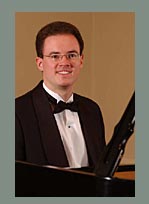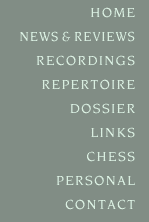 |
 |
 |
|
KAROL SZYMANOWSKI: THEATER IN MUSIC by Dayle van der Sande (This review was also included in full in the Polish Music Center's current newsletter for October, where you can find a picture of the duo on stage: please click here) On Sunday, August 19 at 3 o'clock PM, the Philadelphia Chapter of the Kosciuszko Foundation presented a concert of music by the great 20th-century Polish composer Karol Szymanowski (1882-1937), in celebration of both the 125th anniversary of his birth, and the 70th anniversary of his death. The Sejm proclaimed 2007 as the Year of Karol Szymanowski, and many Polish-American organizations have eagerly produced a concert surveying his music. Those in attendance at the Ethical Society Building on Rittenhouse Square this rainy Philadelphia afternoon enjoyed a variety of diversions. A wine reception preceded the event, and one could place bids on beautiful original oil paintings in silent auction. At intermission there was more wine and some of Polonia's greatest-tasting Polish pastries. Upon meeting violinist Blanka Bednarz and pianist Matthew Bengtson, the audience was instantly warmed by their ease in presenting the program. Both musicians, having concentrated on Szymanowski for their doctoral degrees, preceded each piece with a concise introduction, erudite and academic, yet infused with personality and charm. This marked their tenth concert together in a five-year collaboration of playing Szymanowski's music. The program was an intelligent chronological overview of the composer's body of work, as so many profile programs tend to be. Here, the placement of selections was masterfully designed to offer variety of style and mood, while alternating focus between violin and piano: Sonata in D minor for Violin and Piano, Op. 9, first movement
- Intermission - Sheherazade and Tantris the Clown from Masques, Op.34
The sonata was one of Szymanowski's and the great violinist Pawel Kochanski's favorite pieces to perform together. The day's artists established up front their fine musicianship and technical prowess, and demonstrated skilled ensemble playing, with a symbiotic understanding of mood upon entering a phrase together. Myths for Violin and Piano was presented in its entirety. Here we are introduced to Szymanowski's programmatic music, inspired by his trips to more exotic lands such as Greece and North Africa. Of particular note was the third movement, Dryades et Pan, a masterful work of musical narrative. At once you see Pan dancing across the keyboard in runs. Those of Mr. Bengtson were tight and clean, like talking staccati. Ms. Bednarz's control was remarkable in the trills and harmonic passages, which imitate Pan's flute. She played with great facility, perfectly in pitch, such that one would swear the violin turned into a wind instrument in her hands. The pianistic highlight of the evening was Tantris the Clown. Mr. Bengtson entered into the role of a Pagliaccio as a great actor-pianist. His is a schizophrenic clown, easily shifting mood, color and character from phrase to phrase. His rendering was so compelling, that his clarity of tone and attack and rich Romantic sound could go easily unnoticed. Mr. Bengtson demonstrated courageous playing, as if he were conducting each key on the keyboard as a distinct instrument. The programming of only two movements of this opus was a tease. One hopes there will be a recording of the full cycle. Transporting us further into operatic stories, we hear Chant de Roxane, from King Roger, transcribed for violin and piano by Kochanski. Ms. Bednarz opens Roxane's pleading solo soprano line with imploring sweetness. Yet through a solid tone, she establishes the heroine as a strong woman mustering all her might to appear before the king. When the piano enters, the duo's brilliant choice of tempo betrays Roxane's uneasiness, building in urgency as she submits her plea. Yet, her strength lies in tenderness, finishing in a peaceful cadence. The ensemble performed as one mind, staying in their scene from beginning to end. Here we experience the most moving playing of the concert. Both instruments, with vital tongues, never sacrifice storytelling for “beauty for beauty’s sake.” The players rightfully received a prolonged ovation. In the next set, Mr. Bengtson was at home with the mazurka rhythm as if he were himself a Mazur. In the fast sections, one can imagine from his crisp tempi and rhythmic precision the high kicking boots, the flowing ribbons of the women's flowery headdresses and the feathered caps of the men swirling around in flashes of color, vivacious and frantic, as the composer's marking calls for. In Opus 50, No.14, one could hear a competition being struck up among the village men. Each character tries to outdo the other with their signature steps: the heavyweight, the gallant horseman, the lover all stomp and twirl, putting on a show to win over the girls. In the end, everyone is a winner — especially Mr. Bengtson for demonstrating such far-reaching imagination in bringing the mazurkas to life. His doctoral research and first studio recording was devoted to all 22 of Szymanowski's mazurkas. At this point, the audience was speaking and breathing Szymanowski. Exhilarated, one began to grasp what expertise and endurance is required to execute a program of this magnitude, and what a legacy of genius this composer gave of his soul to the world. We had been escorted through a unique musical journey by two gifted musicians. Then, in a musical exclamation point, the program concluded with a built-in finale, Danse paysanne, from the ballet Harnasie, also transcribed for violin and piano by Kochanski. There is little one can say to convey this stunning piece suitably on paper. It is not a piece of music; it is an experience. It is a portal that takes you to a mountain village in Zakopane where white-haired, light-blue-eyed men wear ecru woolen costumes with wide-brimmed hats and a band of shells; where they yell out throaty, high-pitched songs from one peak to another; where they fiddle out improvised tunes in odd modalities. The piece opens with a plaintive, other-worldly melody like an incantation awakening the Gral spirit. Then the violin flies through pizzicati and successive double-stop octaves and many other exploitative tricks that might make Paganini or Wieniawski break a sweat. The piano pounds out syncopated chord progressions and counterpoint staccati, and together they spin out a whirlwind of gutsy dance rhythms and folk melodies, which spiral faster and faster ending in a quick flourish. I was personally moved by this piece more deeply than any other in the lineup. The playing was magnificently accomplished, and exhibited a fundamental comprehension of the ethnicity in the music. But what fulfilled this piece more than any other element was the raw honesty in the playing of both violin and piano. A more ambitious and fitting tribute could not have been imagined to commemorate the legacy of our hero, Karol Szymanowski and the heritage of Polish music. Dayle Vander Sande, Moderator, www.karolszymanowski.com to send e-mail to Matthew Bengtson. Copyright
2002-2003 Matthew Bengtson |